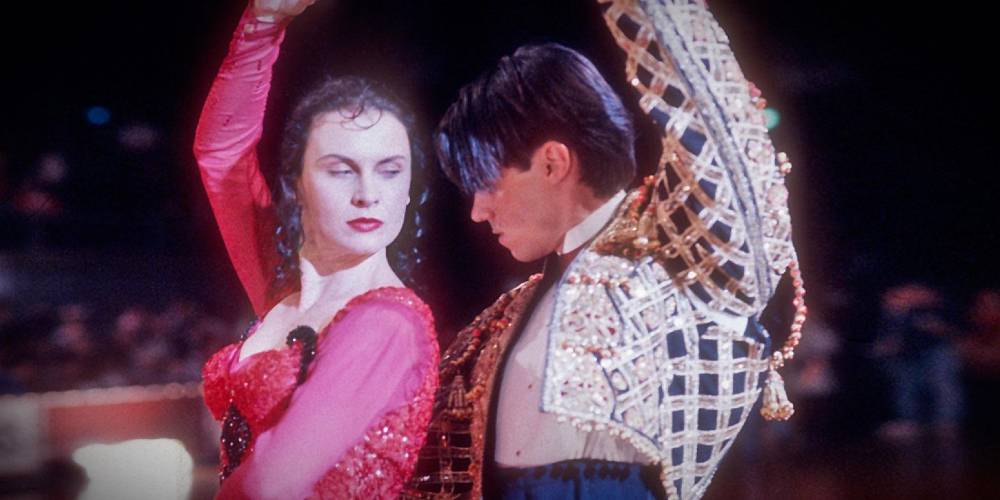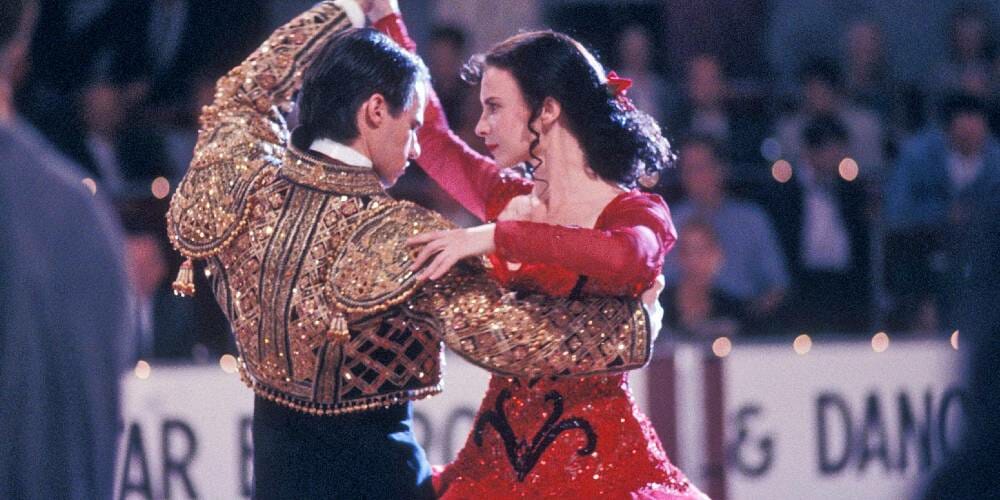Baz Luhrmann’s 1992 feature debut boasts stunning dancing, intriguing ideas, and muddled storytelling.
Strictly Ballroom opens with a faux-documentary post-mortem of a tragedy. Prize ballroom dancing heir Scott Hastings (dancer Paul Mercurio) has stepped out of the agreed-upon rules of ballroom dancing, shattering the social contract of the small community. Dumped by his partner, Liz (Gia Carides), for a crowd favorite, Ken Railings, Scott must team up with the inexperienced and less than glamorous outsider Fran (Tara Morice) to try and wow the judging panel curmudgeons.
It is an entirely enjoyable film, a visual delight, and an easy-to-digest narrative that relies heavily on romantic comedy tropes to ultimately deliver a tale of triumph against an unserious power structure far more rigid than it has any right to be.
Unlike later films in Baz Luhrmann’s filmography, his modern-day Romeo+Juliet, or his career-defining Moulin Rouge!, Strictly Ballroom’s leads have much in common. They are united by their love of dance and general unconventionality in a strictly manicured world. Both Scott and Fran have been cast out of it, but their stakes do not line up even as they share a fight for any kind of status.

Fran does not even have a last name. She is homely, not a very good dancer, and not even from a good family. It does not help that her own goals are ill-defined. Does she simply want to dance? To find romance? To become good enough to win a competition? And Scott is, at least at the start, a poor dance lead. The lead’s duty is to create a safe, controlled environment for their partner to shine. Ideally, a partner is able to react to and riff off the steady, sure steps and body position of their leader. Scott offers none of that security, instead tossing his partners about as he will. It is Fran’s culture and experience that offers Scott his final goal: to prove his different ideas and a chance to win the big competition. It feels exploitative, though one could argue the two find a rhythm in the end.
Strictly Ballroom is top heavy—the dancing with the most flourishes happens in the beginning 30 minutes—the shocking competition presentation that sets off the plot and Scott’s solo dance after the studio has been cleared out. Framed by the denied passion of his father and the restrained indifference of his misleadingly loud mother, the final presentation should feel like an explosion of bodily expression. Instead, it manifests as extremely fine, deceptively traditional Flamenco.
The same argument could be made of Moulin Rouge!, where the massive can-can presentation sets our luxurious scene ahead of the central romance. Unlike the later film, Strictly Ballroom’s working-class Australian setting is not as richly appointed, and Luhrmann, while he will clearly carry the format forward into future films, has not quite honed it.
In the end, Strictly Ballroom’s central pair do find alignment, but the final rejection and coming back together fails to ring true. There is no grandeur wrapped in a love story or massively emotional scene where lovers admit their feelings. Fran has suffered numerous disappointments at this point and is offered a thin reward. Together she and Scott perform a stunning dance number that, while absent Scott’s independent flourish, still elevates the spectacle provided by traditional partner dances in a formalized setting. The romanticism of ballroom dance is impossible to ignore and harder to resist. It is not a sexual form, but it is sensual and relies on a level of trust that can imply sexual or at least romantic intimacy that audiences rarely see outside of traditional romantic pairings.
It’s the way the bodies interact: no one could claim a tango simulates sex. After all, the hips, so important in the penetrative ideal of heterosexual night moves, are centered and solid. It is the limbs that sweep and enclose. They lead the eyes. It’s not true of all partner dances, but certainly of most moves in Flamenco and the other featured dances in the movie. A waltz shifts you physically around the floor as the pair shuffles, but always, like a skilled use of framing, it is leading your eye. Mise en scene, blocking, and camerawork are dressings on top of a well-choreographed dance sequence. The blurring of personal identity, which is a kind of reality, and the scripted characters are part of what imbues the film with its magic. Beyond the grand, colorful costumes, and incredible dance moves, all of which already exist within the world of real-life ballroom, is true love for the craft.
That love shines through in the work of every cast member. Strictly Ballroom was created by a cast of newcomers with a rich background in the subject matter. It was the making of Luhrmann, after he was discovered touring with his stage play version, and featured only a couple of experienced actors. But as Luhrmann already knew from his own studies in a ballroom, the education was rife with the drama and showmanship required to pull off a scene.
When preparing for the role, Paul Mercurio and Tara Morice actually studied flamenco under one of the most famous Spanish dancers in the world, Antonio Vargas. He played Fran’s father and taught the pair both inside and outside the film. Mercurio related that he would also drink afterward with Vargas. They would supposedly talk about passion and women, something the film includes in only a perfunctory way to add tension to a narrative about breaking out expected paths and partnerings.
Moving past the physical movements and into the trappings of Ballroom: The costumes, requisite of any dance drama, were created by Angus Strathie, a long-time friend of Catherine Martin, the street costume designer, and Luhrmann. He also did the stunning outfits on Moulin Rouge!. These outfits are top-tier dance fare, but not necessarily outside the expectations of a flamboyant competition—which itself points to one of the picture’s major problems.
There is an argument at the center of the film that is poorly laid out, but true nonetheless. Because ballroom dance is so strictly defined, it risks dying out. There is a subtlety in many of the movements that do not translate to a general audience without a lot of education. While Luhrmann alludes to a future for the highly traditional form of dance in our combined peanut gallery and Greek chorus, the young students of the classes, he fails to delve into the depths of their boredom. The truth is that without ingenuity, dance loses its audience as quickly as figure skating or gymnastics did after the flash bang of the spectacle offered by full Olympic coverage in the late 80s and 90s. Even then, these were sports driven by characters whose stories of triumph, romantic dramas, and violence.

The idea of bigger, flashier moves like the ones offered by Scott to his audience is not a new concept. They offer an increased spectacle, but interest in them is short-lived. Sports like dance need ambassadors to act as bridges for new audiences. Many movies have tried this, notably the Drew Barrymore-directed Elliot Page vehicle Whip It, which aimed to capture and expand the aughts roller derby zeitgeist. While Strictly Ballroom remains a cult classic, especially outside of Australia, its critical success has followed the path of Ballroom itself. While regular competitions are not as well-viewed as, say, Olympic figure skating, the spectacle has carried over into television programming, first beginning with the celebrity dance competition “Strictly Come Dancing” in the UK in 2004, and the American spin-off “Dancing with the Stars” directly behind in 2005.